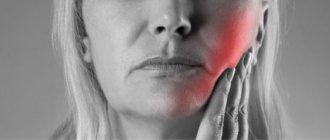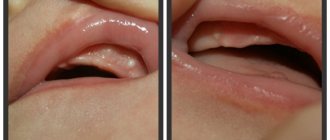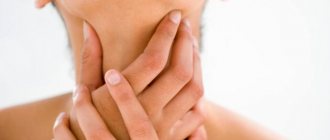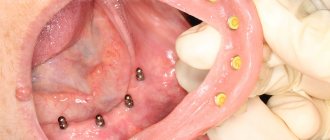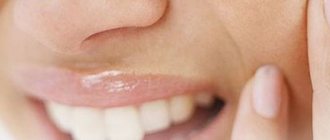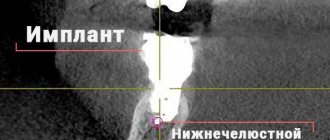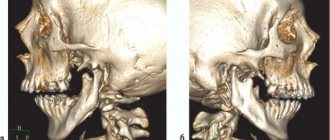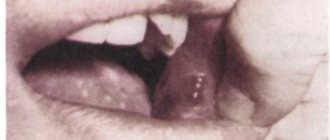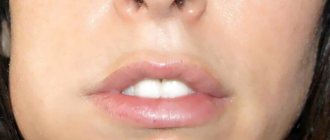The oral mucosa is susceptible to infection and inflammation due to the many microbes present here. Most often, complications arise due to decreased immunity. That is why various blisters on the gums and other parts of the oral cavity should alert a person and force them to seek professional advice and treatment. Small blisters and almost invisible rashes occur with dangerous viruses, and if left unchecked they can cause many problems.
Description
This unpleasant phenomenon can affect both adults and children, causing discomfort and pain when eating.
The appearance of white blisters on the gums as a result of damage to the oral mucosa contributes to burning and itching; such symptoms are especially painful for young patients.
It is not for nothing that experts say that the condition of the oral cavity is a kind of mirror that reflects the state of human health. You can provide first aid in the presence of such a pathology at home using traditional methods.
After treatment, preventive measures are required to prevent the recurrence of blisters on the gums. Externally, they appear as small transparent or white blisters, which are located in various places of the oral mucosa. Most often they appear in small groups. The inflamed areas become covered with a characteristic white or yellow coating.
It hurts/doesn’t hurt: in what cases does pain occur?
Periostitis is considered the most painful. With this complication, the main inflammatory process is localized in the area of the bone and periosteum, which causes severe pain. Seals caused by the inflammatory process in the periodontium (gingivitis, periodontitis) are disturbing when pressed, thermal and mechanical influences are applied. Epulis and ecostosis, as a rule, are not accompanied by pain, but when damaged and inflamed, they also disturb the patient.
A lump near a tooth with periodontitis may not cause noticeable pain, especially if it has a fistulous tract. It is important to understand that the absence of pain does not mean that treatment can not be carried out. In most situations, the tooth can be saved, but some patients are very negligent about their health and consult a doctor in extreme cases. A lump above (or under) a tooth is quite an alarming signal, which often indicates the development of quite serious diseases.
Why do adults get blisters on their gums?
A person’s mouth constantly contains a large number of pathogenic organisms and microbes. Even with daily high-quality cleaning and proper care, the ideal balance is not achieved. Doctors, not without reason, consider the internal mucous membranes and tongue to be the dirtiest areas. Viruses easily enter the body when a patient coughs or talks, through the air or through the nasopharynx.
Blisters on the gums very often appear in the oral cavity. This rash looks like a soft lump that is filled with fluid. Its color can be whitish or pink; it turns brown due to impurities of pus or blood.
What happens if you don't get treatment?
A bubble on the upper or lower gum cannot be ignored. If the cause of its appearance is a fungus or herpes, then after a while the entire oral mucosa may become covered with blisters, which will cause pain and prevent you from fully eating food.
In the presence of untreated dental diseases, due to which a bubble with pus appears on the gum near the diseased tooth, the infection will primarily affect the root and surrounding tissues, spreading to neighboring units. This situation may lead to the need to remove teeth. If a cyst, abscess, fistula, flux occurs, pus through the bloodstream can spread to internal organs and even reach the brain, leading to sepsis, osteomyelitis, jaw fracture and death.
First signs
The first signs of blisters in the mouth:
- tingling, burning and itching in the mouth;
- the occurrence of pain;
- discomfort while chewing food;
- slight tissue swelling;
- dry mouth.
Based on external symptoms, the dentist can guess what caused the appearance of tumors on the mucous membrane:
- various microorganisms, fungi, infections;
- autoimmune conditions (chronic tuberculosis, hepatitis, HIV);
- allergies to food or drugs;
- consequences of a mouth burn from a hot drink or food;
- advanced conditions of periodontal disease, caries or pulpitis;
- exacerbation of inflammation of internal organs.
The dentist can make a more accurate diagnosis based on laboratory analysis of scraping the contents of the vesicle and the mucosal surface. The cause of blisters on the gums in half of the cases is the herpes virus.
Medical statistics say that active manifestations of this disease are observed in 80-90% of patients of different ages. Symptoms of the initial form or permanent relapse are most often diagnosed in children of the first year of life and elderly people with a weakened body.
Characteristic sign of herpes
A characteristic feature of oral herpes is a sudden jump in temperature. The patient feels severe weakness in the lower extremities, lack of appetite and a desire to sleep. Small blisters with clear or cloudy liquid appear on the inside of the cheek or gum. These areas hurt when touched, and they burn when eating. After a few days, they open and bright red wounds form. If treated incorrectly, the rash reoccurs and begins to spread to the larynx and palate. This is fraught with severe complications for humans.
Other diseases
Another pathology that requires the patient’s attention and comprehensive medical supervision is viral pemphigus, which occurs when there is a sudden deterioration in the immune system after tonsillitis, flu or tonsillitis. This problem often complicates the life of cancer patients, occurring after chemotherapy in the mouth. It begins with the appearance of small white blisters on the gums, gradually moving to the inside of the lip, palate and throat. Pemphigus, like herpes, covers the mucous membrane completely, provokes high fever and weakening of the body due to intoxication. Translucent oral blisters can be found on the patient's head and body.
Often in adult patients, a blister appears after tooth extraction. This is primarily due to violation of sterilization standards for instruments. During a minor dental operation, a dentist may introduce bacteria into the wound. At the root, the process of inflammation begins and a cyst filled with purulent exudate is formed. The amount of pus gradually increases, and a blister appears on the gum.
Associated symptoms
The characteristic accompanying symptoms directly depend on the specific type of problem and the cause that caused it. So, for example, a periodontal abscess causes acute painful sensations when pressed and any other mechanical irritation. In this case, the causative tooth may wobble a little, which is due to an increase in the volume of purulent exudate and its attempt to get out.
Under such circumstances, a person usually experiences a general loss of strength, and the body temperature may rise. Sometimes the abscess opens on its own, and then the new growth on the gum will gradually disappear without outside help. But this situation is very dangerous, because pus can lead to infection and intoxication of the body, so if a suspicious lump appears on the mucous membrane, you should urgently run to the dentist.
Reasons for the appearance of bubbles on the gums of a child
Due to its age, the child’s body does not have stable immunity and is not able to adequately resist viral diseases. A watery bump may indicate scarlet fever, measles or chickenpox. Stomatitis is especially common in children - a fairly common process of inflammation of the oral mucosa caused by candida fungi. It is characterized by the following symptoms:
- the appearance of blisters on the gums, as well as on the inner surface of the cheeks or lips;
- erosions that do not heal well;
- itching and burning in the mouth, exhausting the child;
- chills and fever;
- whitish coating on the palate and tongue;
- weakness and drowsiness.
The disease is easily transmitted through dirty household items, toys, and food, so dentists tell parents about the importance of observing all hygiene standards. At the initial stage, inflammation can be quickly stopped, and complications will be excluded.
Another problem for young patients is difficulty in cutting baby teeth. Often, before a molar or incisor appears, a small compaction filled with ichor forms on the gum. The doctor will sometimes gently open the blister to relieve pain and discomfort. With proper care, the wound will heal in a few days, and all unpleasant sensations will completely disappear.
What can cause rashes in a baby's mouth?
When similar neoplasms appear in a child, the probable causes of the problem may be different than in adults. In addition to insufficient oral hygiene, a pathological process can be triggered, for example, by the habit of sucking your thumb in your sleep. Other provoking factors include the following:
- herpes virus: as in the case of adult patients, in infants such rashes on the oral mucosa may be associated with activation of the herpes virus. The blisters burst, and painful ulcers form in their places. This process is usually accompanied by an increase in body temperature, as well as enlarged lymph nodes and a sharp deterioration in appetite,
- chicken pox: a characteristic symptom of the disease is profuse rashes all over the body. Small watery blisters, which can also appear on the mucous membrane, burst and cause severe itching,
- candidiasis: this disease is widely known as thrush, it is quite common among newborns, is characterized by the formation of a cheesy coating on the gums, tongue, inner surface of the cheeks and lips, and may be accompanied by rashes on the mucous membranes,
- viral pemphigus: pathology occurs in both adult patients and children. It is characterized by the formation of blisters filled with a transparent substance throughout the body. After some time, they burst, and the wounds in their places gradually heal.
The photo shows viral pemphigus
When it comes to young patients, blistering rashes on the gums most often indicate an exacerbation of some childhood disease. Less commonly, this symptom becomes a consequence of a serious dental disease.
First aid
Small blisters on the gums, of course, need to be dealt with with the help of a doctor who will make a diagnosis and determine the real cause of the formations in the mouth. Regardless of the number and size of the bubbles, immediate contact with a specialist is required.
As first aid, it is allowed to use antiseptics, pharmaceuticals, disinfecting ointments and special solutions that need to be used to rinse the mouth. These drugs will soothe the mucous membrane, reduce irritation and reduce pain.
This effect can be achieved by using traditional medicine methods.
What can you do as an emergency?
Even before visiting a specialist, you can reduce pain and inflammation, and pharmaceutical painkillers and rinsing with medicinal herbs will help you with this, but only with the permission of the doctor. Here are some important recommendations in this regard:
- do not apply warming compresses to your cheek - heat will only provoke the active spread of inflammation, which can lead to serious complications,
- apply a piece of ice wrapped in gauze to the problematic part of the face - this will help reduce pain,
- take Tempalgin or Ketarolac,
- Rinse your mouth thoroughly with a weak solution of Furacilin or Chlorhexidine to disinfect the tissues.
Chlorhexidine is often prescribed to treat pathology.
Do not take anti-inflammatory drugs or antibiotics without first consulting a specialist. Otherwise, you can only make the situation worse.
Treatment of blisters
You can get rid of blisters on the gums near the tooth if the diagnosis was made correctly by an experienced doctor. Therefore, there is no need to delay your trip to a specialist and lead the pathology to significant complications, risking your own health and loss of teeth. For a blister on the gum caused by a recurrence of herpes infection, the patient is prescribed several therapeutic measures:
- taking antiviral drugs orally (Akiclovir);
- immunity is strengthened through a vitamin complex, aloe vera extract and a course of immunoglobulins;
- a special diet with a reduced content of sweet and rich foods, fats and canned food;
- treating wounds after a blister breaks with antiseptic and healing agents: Metrogyl Denta, Chlorophyllipt, Cholisal.
For rashes due to candidiasis, therapy is based on the use of antifungal drugs. The oral cavity and gum blister are lubricated with a solution of Candida, Decamine or nystatin ointment. For treatment of stomatitis to be effective, the patient needs to take a course of Amphoterecin and Clotrimazole tablets. A good way to remove plaque in the mouth and fight itching is by rinsing with plain soda, which is diluted in warm water.
If there is severe pain due to a bubble on the gum and it is impossible to rest or eat, dentists recommend treating this area with antiseptic ointments. They contain anti-inflammatory substances and gently freeze the nerve endings for several hours. Moreover, most of them can be used to treat children to eliminate discomfort during teething: “Pansoral”, “Kamistad”, “Cholisal”, “Kalgel”.
How else to treat blisters on the gums of an adult and a child?
Gum cancer
This dangerous neoplasm is worth highlighting separately. Mutation cells begin to divide uncontrollably, which is why a red tumor forms on the gum. The disease progresses quickly and over time can develop into jaw cancer.
What are the symptoms?
- General weakness;
- increased body temperature (37 C°);
- loss of appetite;
- constant drowsiness.
The doctor makes an accurate diagnosis after a detailed examination. As a rule, treatment is long and painstaking. With timely medical intervention, the outcome is favorable.
Traditional recipes against inflammation
An affordable and effective way to reduce a blister on the gum is to apply a softened piece of propolis. This natural remedy contains many healing substances that eliminate itching and pain, and reduce swelling around the vesicle. The component can be mixed with Kalanchoe or aloe pulp, fresh honey.
For inflammation of the oral cavity, you can rinse it with decoctions of the following plants:
- sage and chamomile soothe mucous membranes;
- calendula and St. John's wort promote faster wound healing;
- oak bark will eliminate pathogenic microbes.
It is important to follow preventative rules to keep your gums healthy. Dentists advise eating as many dishes with fiber and vegetables as possible, replacing sweets with fruits, and eating sour-milk products. When brushing your teeth, do a small massage by pressing on the mucous membrane, this way the blood will flow.
Is it dangerous that a bubble appears on the gum?
Preparations for the treatment of lumps on the gums
Depending on the diagnosis, the dentist may prescribe special medications aimed at eliminating the inflammatory process.
Table No. 1. For periodontitis.
| Title, photo | Properties |
| Doxycycline | Particularly effective in the progressive course of the disease. |
| Biomycin | Used to eliminate the risk of complications after applying a filling during treatment. |
| Metrogil Denta | Gel for gums, which is used for various gum diseases. It contains metronidazole and chlorhexidine. Together they produce antimicrobial, antibacterial and antiseptic effects. |
| Clindamycin | It is used to treat the disease if the pathogens are resistant to the penicillin group and metronidazole. |
| Cresofen | An antiseptic drug used in dentistry before filling. |
| Antihistamines | Tavegil, Loratadine, etc. Reduce the permeability of capillary walls, reduce swelling and prevent its development. |
| Chlorhexidine | The antimicrobial property of the drug allows it to be used as a mouth rinse. |
| Parodontax toothpaste, President exclusive | Antiseptics and anti-inflammatory drugs help reduce swelling. |
| Paracetamol, analgin | Painkillers and antipyretics. |
| Chamomile, calendula, yarrow | The raw materials are mixed in equal proportions, 60 g of the mixture is poured with 400 ml of boiling water and infused in a thermos for 30 minutes. Then it is filtered and used to rinse the mouth 4-5 times a day. |
Table No. 2. Treatment of epulis.
| Title, photo | Properties |
| Dimexide | It has anti-inflammatory, analgesic and antiseptic properties. Delays tissue proliferation. |
| Miramistin | The oral cavity is irrigated, the effect is antiseptic. |
| Resorcinol | In the form of an ointment, it is used for tissue regeneration, has anti-inflammatory and healing properties. |
| Hydrocortisone | Anti-inflammatory and antiallergic effect. Narrows small vessels at the site of inflammation, inhibits the exudation stage. |
| Calendula or chamomile decoction | Dry plant in the amount of 2 tablespoons, pour 1 glass of boiling water and let it brew. After cooling, strain. Rinse your mouth several times a day. |
Table No. 3. Gingivitis and other gum diseases accompanied by swelling and bleeding.
| Name, photo | Properties |
| Solcoseryl | The ointment is used to activate tissue metabolism processes and improve tissue regeneration. |
| Vitamin complexes that contain folic acid, vitamin E, C, A, B vitamins, zinc, calcium, etc. | The antioxidant properties of vitamins and minerals restore gum tissue, prevent bleeding, and strengthen the immune system in general. |
| Antibiotic from the groups of fluoroquinols and glycosamides: lincomycin, clindamycin, ofloxacin | Used for ulcerative-necrotic form of gingivitis. |
| Toothpaste: Lakalut active, Lakalut phytoformula, Paradontax | Reduce bleeding and restore weakened enamel. They have an antiseptic and anti-inflammatory effect. |
| St. John's wort | A tablespoon of dried plant is poured with 1 cup of boiling water and left covered for about 1 hour. Then strain and rinse your mouth several times a day and always after meals. |
Toothpastes for periodontal disease
Prevention
Like treatment, the prevention of small blisters on the gums will be determined by the causes of the disease. But there are several general recommendations that apply to all cases.
Compliance with the rules of hygienic treatment of the oral cavity is of paramount importance. Every 3-4 months you need to buy a new toothbrush, use mouthwash and dental floss. Taking vitamin and mineral complexes and fresh dairy products is also an excellent preventive measure against the appearance of blisters in the mouth.
It is necessary to stop smoking as much as possible, limit the consumption of alcoholic beverages and exclude snack foods and processed foods from your diet.
It is easier to prevent any disease rather than treat it. That is why it is necessary to monitor the condition of the oral cavity, wash fruits and vegetables well before eating and carefully monitor that children do not put foreign objects in their mouths.
If all recommendations are followed, a person will not be affected by the problem of transparent bubbles appearing on the gums.
Real clinical case (baby tooth) –
- In Fig. 4a, you can see that in the projection of the roots of one of the baby teeth of the upper jaw, a purulent lump has formed on the child’s gum. Depending on the degree of filling with pus, the lump can be soft or dense when pressed; in the latter case, pressure will cause acute pain.
- Figure 4c shows an x-ray of the causative tooth that caused inflammation in this case. The area on the radiograph, limited by the white circle, is a zone of purulent inflammation in the area of the roots of the baby tooth. Above this zone we can see the germ of a permanent tooth, which is located almost between the roots of a milk tooth (24stoma.ru).
Important: what to do if the lump bursts...
Sometimes spontaneous opening of a purulent abscess may occur, i.e. the lump can simply burst, and in its place a fistula is formed (Fig. 5). A fistula is usually called a hole in the gum, which through the fistula canal is connected to the source of inflammation at the apex of the root of the “sick” tooth. Purulent discharge will gradually be released from the fistula.
It is important to understand that the opening of a lump and the formation of fistulas does not mean the cessation of inflammation, even if the fistulas also disappeared over time. The inflammation will simply become chronic and will proceed unnoticed until the next decrease in the child’s immunity - after which the inflammatory process will worsen (pus will begin to form again and swelling of the gums will occur).
